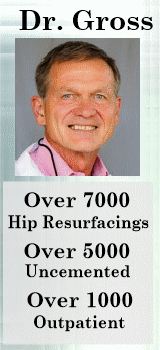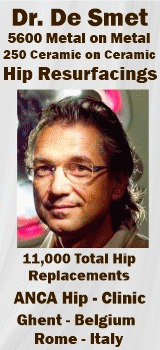Dr. Gross prepared this response and asked me to post.
THE DURABILITY OF HIP RESURFACING
Thomas P. Gross, MD
13 years experience. Over 3000 cases.
For more information: grossortho.com
A recent Article in the Lancet medical journal has criticized hip resurfacing arthroplasty (HRA) as less durable than cemented 28mm total hip replacement (THR). I take exception to the inappropriate conclusion that the authors drew from this highly flawed study.
However, there are two conclusions that can be drawn from this study. Surgeons, who are inexperienced in hip resurfacing, have more revisions in the short term with resurfacing than if they stick with standard hip replacement. Women have a higher failure rate than men with hip resurfacing. Both of these are old news.
Hip resurfacing has several distinct advantages over stemmed small bearing total hip replacement. The resurfaced hip most closely resembles the natural hip. Biomechanically the hip is stable, most of the bone is preserved and stresses are transferred more naturally to the remaining bone. Near normal function can be achieved, even by impact athletes. Thigh pain (3-5% of stemmed THR) does not occur in resurfacing. Dislocation is rare (<0.5%), and revision for recurrent instability is extremely rare (0.03%).
The problem is not with resurfacing. The first problem is that two poorly designed hip resurfacing implant systems were released into the marketplace. The second problem is that too many surgeons have dabbled in resurfacing and never achieved enough experience with this difficult operation to get over the learning curve. It is worth emphasizing that the average surgeon volume for resurfacing in the Lancet study was 3.7 cases / year. The results of inexperienced hip-resurfacing surgeons are nicely captured in the Lancet article.
Therefore, the first challenge is to develop more specialist surgeons who can match the current results of numerous high performing hip resurfacing surgeons. The second challenge is to elucidate the underlying reasons why women have more failures with resurfacing and find ways to improve the outcome in women.
My conclusions from this study, the other available data and my personal experience with hip resurfacing are:
• Most orthopedic surgeons are not qualified to perform hip resurfacing.
• Very high failure rates are achieved by surgeons who perform an average of only 40 resurfacings / in 7 years (4.6 cases/year).
• Cemented 28mm total hip replacement has an unacceptably high failure rate in young patients.
• Hip resurfacing done by specialists in hip resurfacing has a high success rate in young patients.
• All young patients requiring a hip replacement should be referred to specialist hip resurfacing surgeons. Young patients’ risk of failure is higher if they have a 28mm cemented THA or if they have a HRA by a surgeon who is inexperienced in this operation.
• If you are a patient who wants a hip resurfacing, choose a surgeon who can demonstrate (in writing) a personal high success rate with this operation.
A recent article analyzing and comparing failure rates of various hip replacement types has recently been published in the Lancet Medical Journal. It finds that the revision rate for hip resurfacing among hundreds of surgeons in England and Wales is higher than the revision rates for cemented 28 mm cemented total hip replacements. Therefore, they suggest that hip resurfacing should be abandoned. They focus particularly on 5 -year survivorship data; the failure rates reported were:
• Resurfacing, all patients: 5.2%
• Resurfacing in men: 3.5%
• Resurfacing in women: 8%
• Cemented 28 mm M/P THR: 2.8%
I am concerned with the revision rate reported among this cohort of 698 English and Welsh surgeons trying to perform hip resurfacing. My personal experience is completely different than what these British surgeons can achieve.
I have now performed 3000 hip resurfacings since 1999. This is more than 10% of the entire British experience reported on in this Lancet article. I have practiced very limited patient selection. About 2/3 of my patients are men and 70% have osteoarthritis. I do not avoid patients with smaller implant sizes. I have maintained follow-up on 92% of my patients. I keep track of causes for revision as well as complications. My 5-year failure rates are as follows:
• Resurfacing, all patients: 2.8%
• Resurfacing in men: 1.9%
• Resurfacing in women: 5.2%
• Uncemented Resurfacing: 1.9%
• Uncemented resurfacing in men: 0.9%
• Uncemented resurfacing in women: 5.1%
How can we explain this significant difference?
Should I accept the conclusions of AJ Smith et al from the British Joint Registry Data published in the Lancet and discontinue hip resurfacing?
I think we can safely conclude one thing from the Lancet article:
Many British surgeons are NOT qualified to perform hip resurfacing and should abandon this procedure.
The problem is, that previous registry studies have shown that young patients have much higher 10-year failure rates with cemented THR. In fact, this same Lancet article quotes a Finnish registry study showing a 28% failure rate at 10 years for cemented THR.
Although the Lancet article confirms that most surgeons cannot perform hip resurfacing well, several high volume hip resurfacing surgeons have demonstrated far lower failure rates than 5% at five years or 28% at 10 years: McMinn, Treacy, Amstutz, DeSmet, and myself, for example.
This indicates that young patients should not receive cemented 28mm THR, they should not receive resurfacing from inexperienced resurfacing surgeons, they should rather be referred to specialists in hip resurfacing who CAN achieve high success rates with hip resurfacing.
Although large registry studies are one valuable source of information for surgeons, it would be foolish to use only registry data to make all of our decisions. There are many shortcomings of registry data:
1. Only revisions are counted as failures.
2. Complications are not reported.
3. Function is not assessed.
4. Bone preservation is not considered.
5. Patient activity level and restrictions are not evaluated.
6. The effect of surgeon skill is disregarded.
7. Overall effect on the patient’s life is not measured.
Before addressing these issues, I have two other major concerns with this study:
First is their low rate of follow-up. The methods section states the analysis is based on 82% of THR’s undertaken. What happened to the other 18%? This is supposed to be a national joint registry? My data is based on 92% rate of follow-up and I don’t have the benefit of a national registry. This fact alone casts great doubt over the entire study.
Second is their choice of implant inclusion. They did appropriately remove the DePuy ASR implant from analysis (recalled by DePuy in the US 2010). But the Zimmer Durom was another failed implant, which was removed from the US market in 2008 because of a high failure rate. Why was this implant not removed from this analysis?
Now we will critique the other shortcomings of registry studies listed above:
1. Because registry studies only count revisions as failures, it is not known which group studied has more unrevised but failed implants. If a patient has an implant has a loosened painful implant but is not revised, this is still considered a success by the registry. If a patient has suffered three dislocations but has not been revised, this is still considered a success by the registry.
2. Dislocation is the most common complication in THR but almost never happens in hip resurfacing. A recent randomized controlled study from Australia has shown the dislocation rate of 28mm THR to be 5.2% within the first year after surgery. The most common reason for revision for THR in the US is dislocation. It accounts for more than 20% of all THR revisions in the US. My rate of dislocation for HRA is < 0.5%. Only 1/3000 (0.03%) have required revision for this problem.
In HRA, bearing size is the same as the natural hip and the normal hip biomechanics are closely reproduced, leading to normal hip stability. After a 6-month healing period, patients can bend their hip how they like and engage safely in all sports including gymnastics and kayaking. This is simply not possible to do with a 28mm THA.
But the Lancet article suggests that resurfacing should be abandoned? This is an ivory tower conclusion that ignores the desires of many younger patients sidelined from an active lifestyle or from physical work because of an arthritic hip. These young people would be unable to return to their desired activities after a standard THA. Apparently the Lancet authors have not considered this fact. A 28mm cemented THA simply does not meet the needs and desires of many young patients. It does not compare to an HRA.
3. Patients with THR are usually not able to resume as high a level of function as those with HRA. If they do manage to return to impact activities, they have a high rate of implant failure. HRA only has a higher rate of implant failure at extreme levels of activity, and most of those are from failure of femoral cement fixation.
Functional potential is much greater after HRA. If a patient wishes to golf, walk or even use an elliptical it is doubtful that they would notice the difference between a HRA and a THR. But if they are interested in physical work or impact sports they are much more likely to resume these after HRA. 4/5 published gait studies have shown normal gait with HRA, but abnormal gait with THR. 2 large comparative survey studies by Barrack and Noble have shown a much higher activity level achieved by young people if they had an HRA compared with THR. In a 15-year comparative study Argenson has recently shown that THR had a 6.5% loosening rate in low activity patients and a 20% rate in patients with a high UCLA Activity score (partaking in impact sports). Amstutz was unable to show any difference in implant survivorship after hip resurfacing at 10 years when using the UCLA activity score, but could show a difference when using a much more rigorous hip impact score (3.6% vs. 11.2% failure at 8 years; 70% of failures were cement loosening of the femur).
Resurfacing clearly allows better function and tolerates higher level of activities. The primary remaining challenge is failure of fixation of the cemented femoral component. I predicted this 12 years ago and therefore have pursued uncemented femoral fixation. The results at 5 years are promising, but not yet conclusive.
4. Bone preservation for future revision surgery is still an important consideration in young patients needing a hip replacement. The amount of bone removed from the acetabulum in the original THR is similar to that for HRA. But on the femoral side much less bone is removed during HRA than in THR where the entire head and half of the femoral neck are removed. Removing a stem from inside the femoral canal can lead to further bone destruction at the time of revision of a THR. Many patients are justifiably not sufficiently confident in the durability of THR to allow surgeons to amputate their femoral head and neck at a young age. But the authors of the Lancet article do not consider bone loss.
5. Patients that have an HRA with a cemented femoral component can safely participate in impact sports, but should refrain from extreme impact activities such as running long distances. Patients with uncemented resurfacing are not restricted from any activity after 1 year after surgery. Because the hip ligament heals after 1 year, full unrestricted range of motion is allowed for all HRA. Neither impact activity nor extreme bending is advisable for cemented 28mm THA. 40% of my patients choose to participate in impact activities after HRA. When a registry study compares THR to HRA can they possibly be comparing equivalent patient populations?
6. HRA is widely acknowledged to be a more complicated operation to master than THR. There are few if any orthopedic residents that learn this operation during their training. If a surgeon is interested in resurfacing, he has to mostly learn it himself. Numerous studies have indicated that the learning curve is long. In a study of my first 373 HRA, my failure rate continued to fall after the first 200 cases. The Lancet study reports on 26,119 HRA done by 698 surgeons over 8 years; an average of 37 cases per surgeon or 4.6 cases/surgeon/year. They claim to account for the “learning curve” effect. This is a ridiculous claim when most British surgeons in this study have performed fewer than 100 HRA.
7. In a recent study evaluating the same English and Wales registry, McMinn has found that life expectancy for men after HRA is greater than after THR. Results were adjusted for age, gender and level of health but not for activity. There are several possible explanations.
• Perhaps patient populations in the British registry who have HRA are not the same as those that have THR despite the fact that age and health status were controlled. If this is true, how can the Lancet article then compare failure rates between two different groups of patients in a meaningful fashion?
• If young patients who receive HRA have a higher functional level than THR patients, perhaps the positive effects of exercise account for their lower mortality?
• Perhaps there is something in the technique or materials of a THR that are deleterious. For example, fat embolism occurs with femoral preparation in THR but not in HRA. This may cause previously unrecognized permanent cardiopulmonary dysfunction. Critics of metal on metal bearings have long speculated that cobalt and chromium released by HRA bearings may cause cancer or other ill effects. The potential cancer effect has long been disproven with studies up to 30 years. Now it appears that patients with these metal bearings actually live longer! It will be interesting to learn why patients with THR have a shorter life expectancy than patients with HRA.
In summary, the conclusions of the Lancet study are based on a very limited and superficial analysis of THR vs. HRA. The Lancet study only illustrates that a patient should not allow an inexperienced hip-resurfacing surgeon to perform his/ her operation. It confirms what many other studies have already shown: that women have a higher failure rate than men with HRA, but it adds no new information on why this may be true. There are numerous advantages of resurfacing that are simply not evaluated by this study. The Australian hip registry shows a better survivorship for young men with HRA. Young active people are not able to resume their desired lifestyle with THR.
Young sporting people or physical workers should be advised that THR will relieve their pain but will not safely allow them to resume their lifestyle. Surgeons who are not experienced with HRA should not attempt to perform this operation without warning their patients that their failure rate is probably much higher than that demonstrated in specialist centers. Data from this Lancet study suggests that young active patients should be referred to specialist centers for hip resurfacing with demonstrated low failure rates with this procedure. In England, for example, a vast difference in outcomes is seen between Oxford and Birmingham. More than with most other procedures, it is critical for the patient to do their homework before undertaking HRA and to select a surgeon who can demonstrate a high success rate with this operation.
References:
1. Ollivier et al; CORR 2012. Does Impact sorts Activity Influence Total Hip arthroplasty Durability?
2. LeDuff et al; JBJS Am 2012. The relationship of sporting activity and implant Survivorship After Hip Resurfacing.
3. Smith et al; The Lancet 2012. Failure rates of metal-on-metal hip resurfacings: analysis of data from the National Joint Registry for England and Wales.
4. McMinn et al; British Medical Journal 2012. Mortality and implant revision rates of hip arthroplasty in patients with osteoarthritis: registry based cohort study.
5. Gross et al; Journal of arthroplasty 2012 Hip resurfacing with the Biomet Hybrid Recap-Magnum System
6. Gross et al; Journal of arthroplasty 2011. Clinical Outcome of the Metal-on-metal Hybrid Corin Cormet 2000 Hip Resurfacing System
7. Brekke, Noble et al; ISTA 25th Congress Sydney Australia 2012. Patient Function and Satisfaction After Large Head Total Hip Arthroplasty versus Hip resurfacing.











